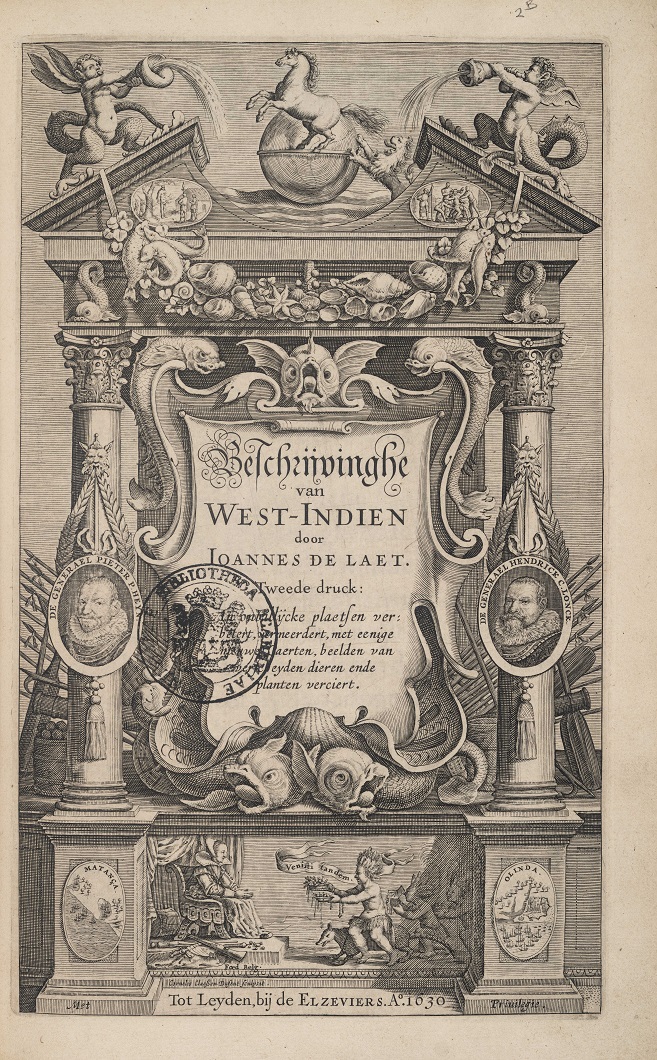Caribbean
Ruben Klijnsma
This contribution is published in both Dutch and English. You will find the English version below.
| Nummer Koeman’s Atlantes Neerlandici, vol. II | 9640:2 |
| Titel kaart / Titel tekst | CANIBALES INSVLÆ / D’Eylanden Der Canibales |
De reizen van Columbus (1451-1506) en opvolgende Europese exploratiereizen richting het westen openden vanaf 1492 voor Europa letterlijk een Nieuwe Wereld. De eerste van deze reizen eindigde bij de eilanden die we nu kennen als Puerto Rico, Haïti, de Dominicaanse Republiek, Jamaica, Cuba en de Caraïben.
De voornoemde eilanden werden door Joan Blaeu op merkwaardige wijze beschreven. Op het eerste oog lijken de beschrijvingen van de eilanden vrij objectief. Allerlei aardrijkskundige, geografische, maar ook economische aspecten worden behandeld. Toch zijn er ook enkele aspecten die voor de hedendaagse lezer bepaalde vragen oproepen.
Het grootste vraagteken kan gezet worden bij het thema kannibalisme, dat, zoals enigszins te verwachten, voornamelijk naar voren komt in de beschrijving van D’Eylanden der Cannibales, vandaag de dag bekend als de Caraïbische eilanden. Blaeu schrijft in deze passage in zijn Grooten Atlas onder andere over ‘mensch-eters’ en ‘wilden’ als hij het heeft over de oorspronkelijke inwoners van het gebied dat wij nu kennen als de Caraïben.

Johannes De Laet, Beschrijvinghe van West-Indien (Leiden: Elzevier, 1630)
Hoezo werden de oorspronkelijke bewoners van dit gebied op deze manier afgeschilderd in de atlas van Blaeu? Dit komt doordat hij zijn tekst baseerde op de omschrijving van West-Indië door Johannes de Laet. Op meerdere plekken kopieert Blaeu De Laet zelfs letterlijk. In de werken van De Laet komt ook kannibalisme voor, maar hij was niet de enige auteur. In vele reisverhalen en andere verslagen kwamen de kannibalen van de Caraïben voor; ons woord kannibaal is zelfs afkomstig uit dit gebied.
De huidige consensus over dit beladen thema is dat de karakterisering van de bevolking als kannibalen onjuist is. De verhalen van kannibalisme in de Caraïben zijn voornamelijk van horen zeggen en de enige “ooggetuigenverklaringen” die wel authentiek zijn berusten hoogstwaarschijnlijk op culturele misverstanden, incomplete verhalen en/of regelrechte verzinsels.
De karakterisering van de oorspronkelijke bewoners van deze eilanden als kannibalen heeft echter veel impact gehad. Doordat de bevolking werd geduid als ‘wilden’ of ‘kannibalen’ werd de primitiviteit van de bewoners en de zogenaamde superioriteit van de Europeanen benadrukt. Dit leidde onder andere tot de legitimering van de Europese suprematie over en daarmee de decimering van de lokale bevolking in deze regio.
Suggestie om verder te lezen:
Arens, W. (1979). The man-eating myth: anthropology & anthropophagy. New York: Oxford University Press.
| Koeman’s Atlantes Neerlandici, vol. II | 9640:2 |
| Title map / Title text | CANIBALES INSVLÆ / D’Eylanden Der Canibales |
From 1492 onwards, the westward voyages of Christopher Columbus (1451-1506) and other European explorers who followed in his footsteps literally opened up a whole New World for Europeans. The first of these voyages ended at the islands we now know as Puerto Rico, Haiti, the Dominican Republic, Jamaica, Cuba, and the Caribbean islands.
Joan Blaeu had a peculiar way of describing these islands. At first glance, his descriptions seem fairly objective. They cover geospatial, geographical, and economic aspects. That said, he also raises a number of issues that are questionable by modern-day standards, the main one being cannibalism, which – as might be expected – features prominently in the description of The Islands of the Cannibales, the present-day Caribbean islands. In his passage about this region in his Atlas Maior, Blaeu writes about ‘mensch-eters’ [man-eaters] and ‘wilden’ [savages].
Why did he describe the indigenous population like that? It was because he based his text on Johannes de Laet’s description of the West Indies. Blaeu even copied De Laet literally in some instances. De Laet talked about cannibalism, but he was not the only author to do so. The cannibals of the Caribbean feature in many travel journals and other reports too and the word cannibal even has its origins in this region.
The current consensus on this controversial theme is that there was no substantiation for depicting the population as cannibals. The stories about cannibalism in the Caribbean are mainly based on hearsay. The only ‘eyewitness accounts’ that are authentic were probably due to cultural misunderstandings, incomplete stories, and/or downright fabrications.
But the characterization of the indigenous peoples of these islands as cannibals was not without its impact. Because of it, the indigenous peoples were regarded as savages or primitives, which served to stress the Europeans’ superiority, which in turn resulted in the legitimization of the European supremacy over, and the decimation of, the local population.
Further reading:
Arens, W. (1979). The man-eating myth: anthropology & anthropophagy. New York: Oxford University Press.
